PHC NCS 3102 - Assessing Health of Thai Women Migrants in Australia
VerifiedAdded on 2023/06/09
|13
|3302
|431
Report
AI Summary
This report provides a comprehensive assessment of the health status of Thai women migrants in Australia, focusing on demographics, prevalent health issues, and the social determinants of health influencing their well-being. The report highlights that Thai women in Australia experience a disproportionate burden of chronic diseases, mental health problems, and domestic violence. Language barriers, cultural differences, and socioeconomic factors significantly impact their access to healthcare services and adherence to preventive health programs. The report also addresses specific health concerns such as HIV/AIDS and the potential impact of traditional dietary habits on glycaemic control. Ultimately, the report emphasizes the need for culturally sensitive and community-based interventions to improve the health outcomes and overall well-being of Thai women migrants in Australia. Desklib offers a wide range of resources, including past papers and solved assignments, to support students in their academic pursuits.
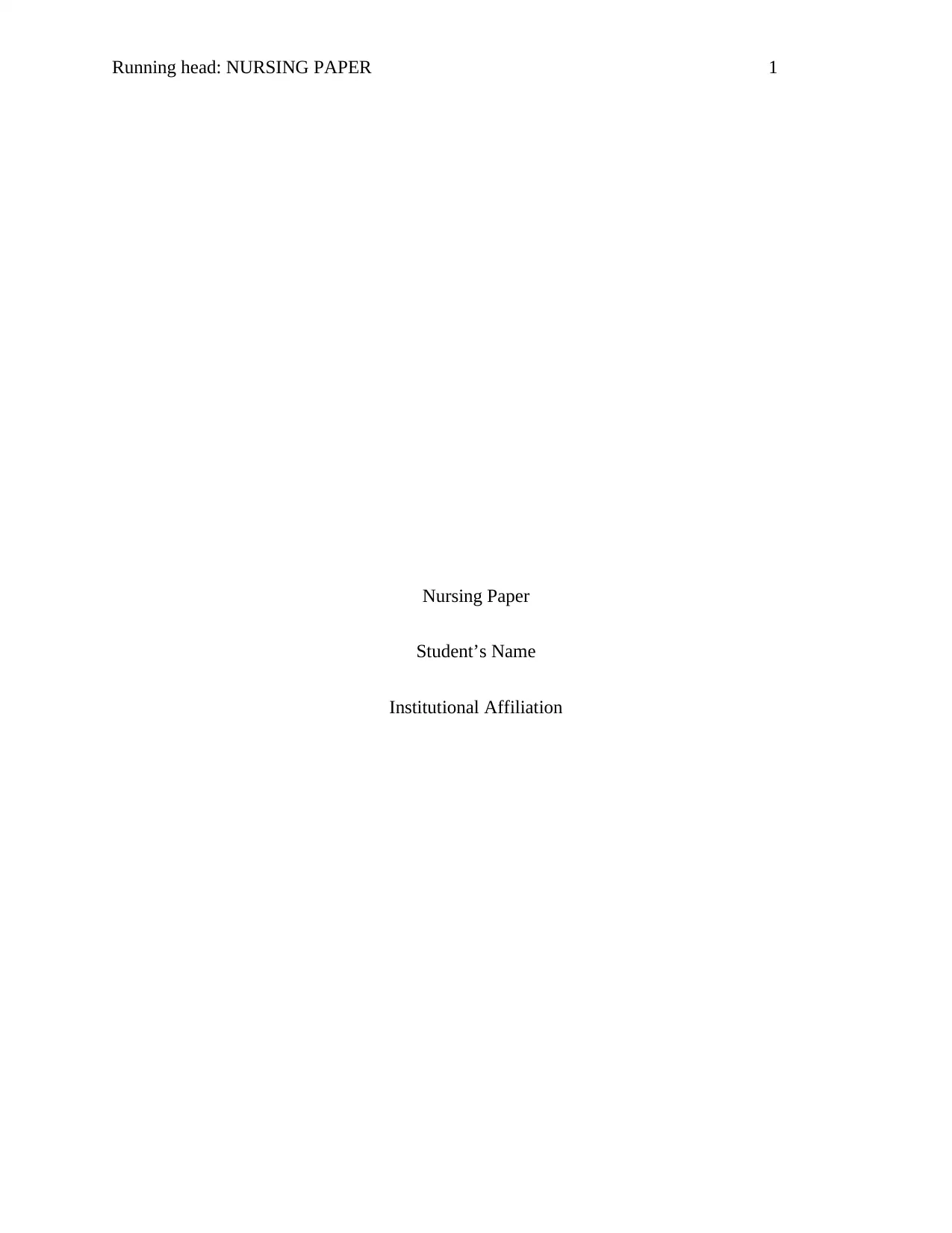
Running head: NURSING PAPER 1
Nursing Paper
Student’s Name
Institutional Affiliation
Nursing Paper
Student’s Name
Institutional Affiliation
Paraphrase This Document
Need a fresh take? Get an instant paraphrase of this document with our AI Paraphraser
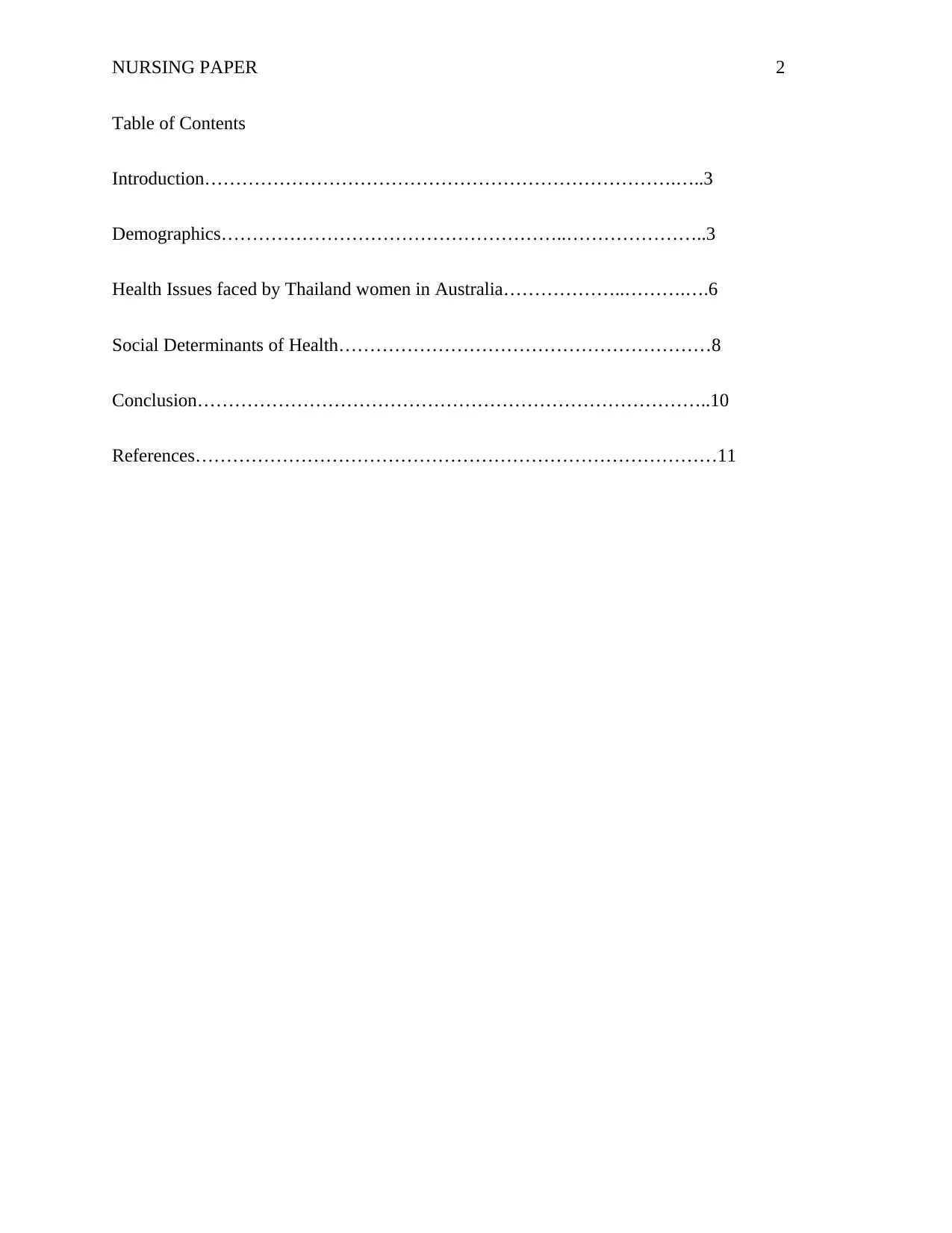
NURSING PAPER 2
Table of Contents
Introduction………………………………………………………………….…..3
Demographics………………………………………………..…………………..3
Health Issues faced by Thailand women in Australia………………..……….….6
Social Determinants of Health……………………………………………………8
Conclusion………………………………………………………………………..10
References…………………………………………………………………………11
Table of Contents
Introduction………………………………………………………………….…..3
Demographics………………………………………………..…………………..3
Health Issues faced by Thailand women in Australia………………..……….….6
Social Determinants of Health……………………………………………………8
Conclusion………………………………………………………………………..10
References…………………………………………………………………………11
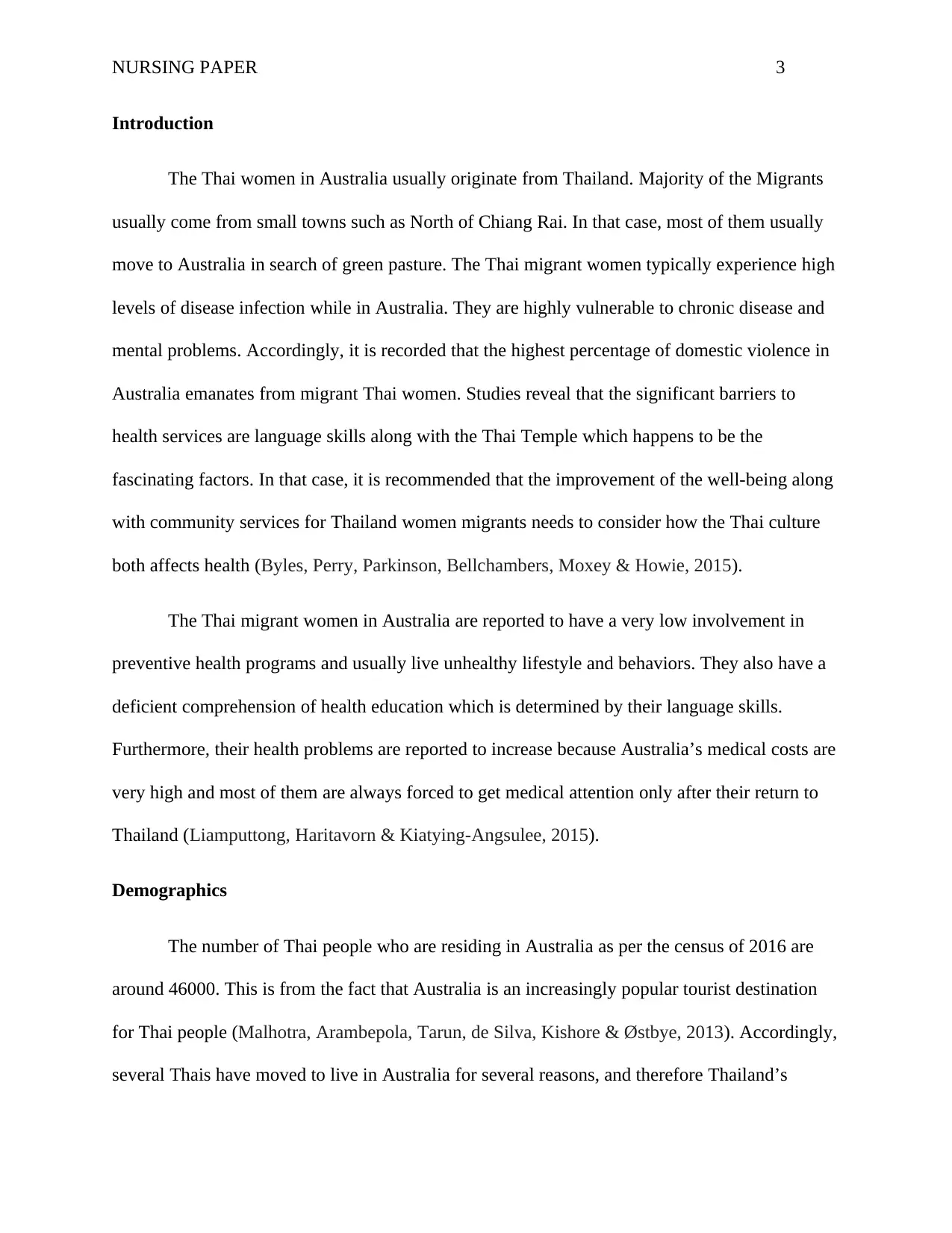
NURSING PAPER 3
Introduction
The Thai women in Australia usually originate from Thailand. Majority of the Migrants
usually come from small towns such as North of Chiang Rai. In that case, most of them usually
move to Australia in search of green pasture. The Thai migrant women typically experience high
levels of disease infection while in Australia. They are highly vulnerable to chronic disease and
mental problems. Accordingly, it is recorded that the highest percentage of domestic violence in
Australia emanates from migrant Thai women. Studies reveal that the significant barriers to
health services are language skills along with the Thai Temple which happens to be the
fascinating factors. In that case, it is recommended that the improvement of the well-being along
with community services for Thailand women migrants needs to consider how the Thai culture
both affects health (Byles, Perry, Parkinson, Bellchambers, Moxey & Howie, 2015).
The Thai migrant women in Australia are reported to have a very low involvement in
preventive health programs and usually live unhealthy lifestyle and behaviors. They also have a
deficient comprehension of health education which is determined by their language skills.
Furthermore, their health problems are reported to increase because Australia’s medical costs are
very high and most of them are always forced to get medical attention only after their return to
Thailand (Liamputtong, Haritavorn & Kiatying-Angsulee, 2015).
Demographics
The number of Thai people who are residing in Australia as per the census of 2016 are
around 46000. This is from the fact that Australia is an increasingly popular tourist destination
for Thai people (Malhotra, Arambepola, Tarun, de Silva, Kishore & Østbye, 2013). Accordingly,
several Thais have moved to live in Australia for several reasons, and therefore Thailand’s
Introduction
The Thai women in Australia usually originate from Thailand. Majority of the Migrants
usually come from small towns such as North of Chiang Rai. In that case, most of them usually
move to Australia in search of green pasture. The Thai migrant women typically experience high
levels of disease infection while in Australia. They are highly vulnerable to chronic disease and
mental problems. Accordingly, it is recorded that the highest percentage of domestic violence in
Australia emanates from migrant Thai women. Studies reveal that the significant barriers to
health services are language skills along with the Thai Temple which happens to be the
fascinating factors. In that case, it is recommended that the improvement of the well-being along
with community services for Thailand women migrants needs to consider how the Thai culture
both affects health (Byles, Perry, Parkinson, Bellchambers, Moxey & Howie, 2015).
The Thai migrant women in Australia are reported to have a very low involvement in
preventive health programs and usually live unhealthy lifestyle and behaviors. They also have a
deficient comprehension of health education which is determined by their language skills.
Furthermore, their health problems are reported to increase because Australia’s medical costs are
very high and most of them are always forced to get medical attention only after their return to
Thailand (Liamputtong, Haritavorn & Kiatying-Angsulee, 2015).
Demographics
The number of Thai people who are residing in Australia as per the census of 2016 are
around 46000. This is from the fact that Australia is an increasingly popular tourist destination
for Thai people (Malhotra, Arambepola, Tarun, de Silva, Kishore & Østbye, 2013). Accordingly,
several Thais have moved to live in Australia for several reasons, and therefore Thailand’s
⊘ This is a preview!⊘
Do you want full access?
Subscribe today to unlock all pages.

Trusted by 1+ million students worldwide

NURSING PAPER 4
makes up a good percentage in different parts of Australia be it Victoria along with New South
Wales (Cox, 2015).
The median ages for Thailand and Australian women as per the 2012 census are 37 and
31 years respectively. Conversely, it is estimated that Thailand women make up around 68 % of
the total Thai people in Australia (Tam & Clarke, 2015). As an illustration, the gender imbalance
is due to the intercultural marriage between Thai women and the Australian men. Census data
further shows that the Thailand born people in Australia have considerable percentages. The
figure below shows the number of women and Men of Thailand people in Australia (Cox, 2015).
Figure 1 the number of Thailand men and women in Australia
Regarding the language spoken, the diagram below shows the types of communication
the immigrant Thai born people talk while in Australia. The primary language spoken by
Thailand-born people in Australia is Thai. Concerning religion, the 2011 census states that the
significant religious affiliation among the Thailand-born was Buddhism, baptism and Catholic
(Peltzer & Mongkolchati, 2015).
makes up a good percentage in different parts of Australia be it Victoria along with New South
Wales (Cox, 2015).
The median ages for Thailand and Australian women as per the 2012 census are 37 and
31 years respectively. Conversely, it is estimated that Thailand women make up around 68 % of
the total Thai people in Australia (Tam & Clarke, 2015). As an illustration, the gender imbalance
is due to the intercultural marriage between Thai women and the Australian men. Census data
further shows that the Thailand born people in Australia have considerable percentages. The
figure below shows the number of women and Men of Thailand people in Australia (Cox, 2015).
Figure 1 the number of Thailand men and women in Australia
Regarding the language spoken, the diagram below shows the types of communication
the immigrant Thai born people talk while in Australia. The primary language spoken by
Thailand-born people in Australia is Thai. Concerning religion, the 2011 census states that the
significant religious affiliation among the Thailand-born was Buddhism, baptism and Catholic
(Peltzer & Mongkolchati, 2015).
Paraphrase This Document
Need a fresh take? Get an instant paraphrase of this document with our AI Paraphraser
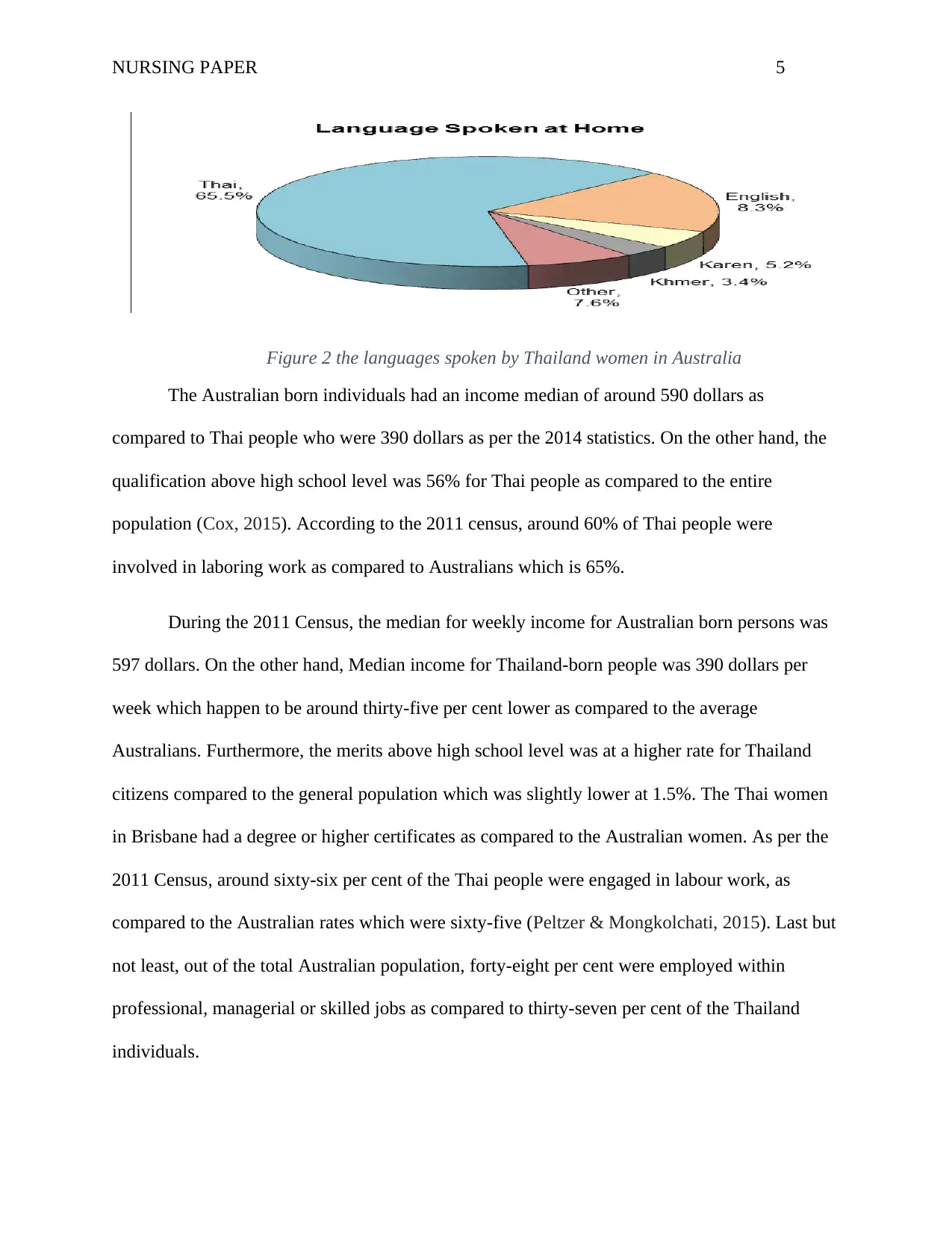
NURSING PAPER 5
Figure 2 the languages spoken by Thailand women in Australia
The Australian born individuals had an income median of around 590 dollars as
compared to Thai people who were 390 dollars as per the 2014 statistics. On the other hand, the
qualification above high school level was 56% for Thai people as compared to the entire
population (Cox, 2015). According to the 2011 census, around 60% of Thai people were
involved in laboring work as compared to Australians which is 65%.
During the 2011 Census, the median for weekly income for Australian born persons was
597 dollars. On the other hand, Median income for Thailand-born people was 390 dollars per
week which happen to be around thirty-five per cent lower as compared to the average
Australians. Furthermore, the merits above high school level was at a higher rate for Thailand
citizens compared to the general population which was slightly lower at 1.5%. The Thai women
in Brisbane had a degree or higher certificates as compared to the Australian women. As per the
2011 Census, around sixty-six per cent of the Thai people were engaged in labour work, as
compared to the Australian rates which were sixty-five (Peltzer & Mongkolchati, 2015). Last but
not least, out of the total Australian population, forty-eight per cent were employed within
professional, managerial or skilled jobs as compared to thirty-seven per cent of the Thailand
individuals.
Figure 2 the languages spoken by Thailand women in Australia
The Australian born individuals had an income median of around 590 dollars as
compared to Thai people who were 390 dollars as per the 2014 statistics. On the other hand, the
qualification above high school level was 56% for Thai people as compared to the entire
population (Cox, 2015). According to the 2011 census, around 60% of Thai people were
involved in laboring work as compared to Australians which is 65%.
During the 2011 Census, the median for weekly income for Australian born persons was
597 dollars. On the other hand, Median income for Thailand-born people was 390 dollars per
week which happen to be around thirty-five per cent lower as compared to the average
Australians. Furthermore, the merits above high school level was at a higher rate for Thailand
citizens compared to the general population which was slightly lower at 1.5%. The Thai women
in Brisbane had a degree or higher certificates as compared to the Australian women. As per the
2011 Census, around sixty-six per cent of the Thai people were engaged in labour work, as
compared to the Australian rates which were sixty-five (Peltzer & Mongkolchati, 2015). Last but
not least, out of the total Australian population, forty-eight per cent were employed within
professional, managerial or skilled jobs as compared to thirty-seven per cent of the Thailand
individuals.
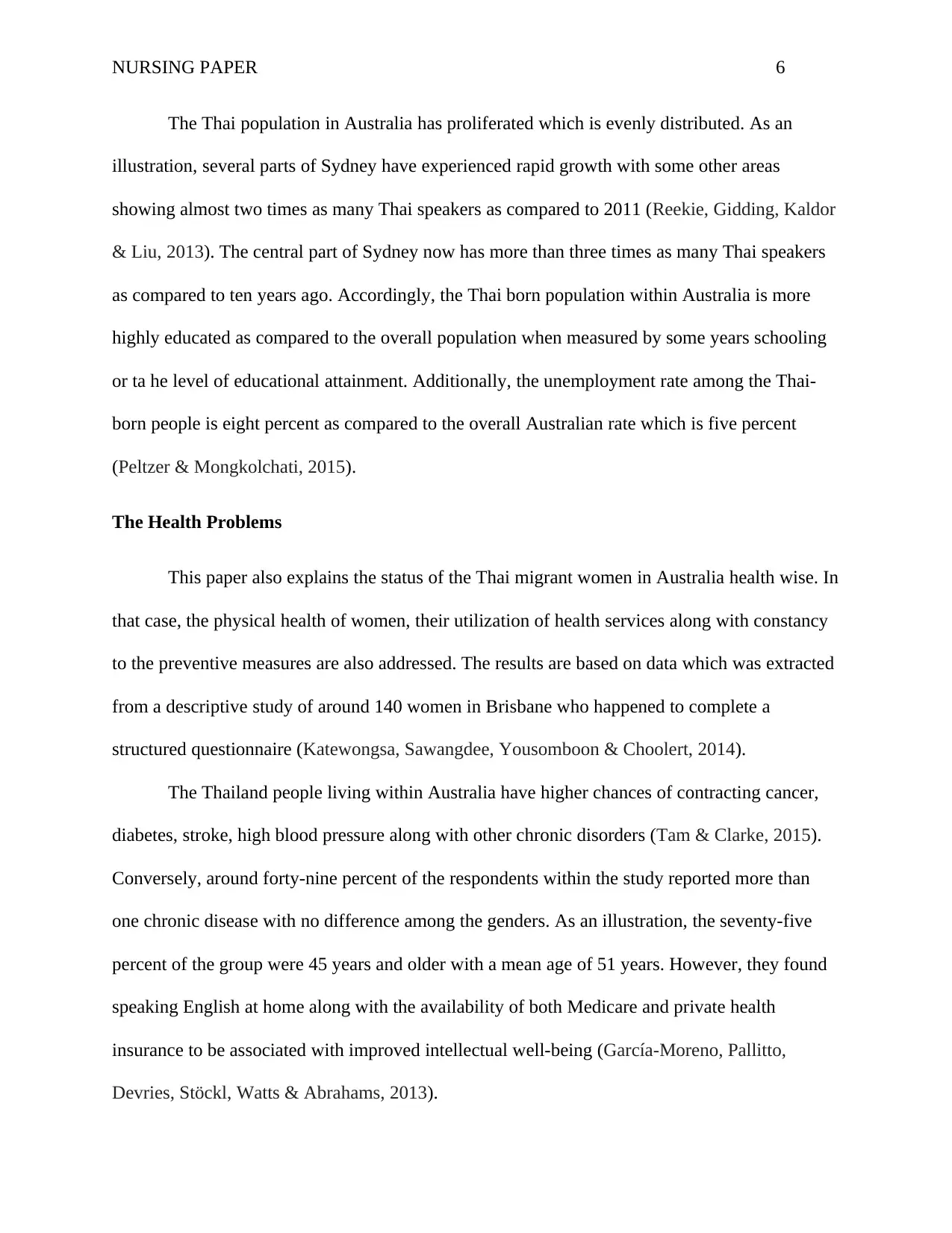
NURSING PAPER 6
The Thai population in Australia has proliferated which is evenly distributed. As an
illustration, several parts of Sydney have experienced rapid growth with some other areas
showing almost two times as many Thai speakers as compared to 2011 (Reekie, Gidding, Kaldor
& Liu, 2013). The central part of Sydney now has more than three times as many Thai speakers
as compared to ten years ago. Accordingly, the Thai born population within Australia is more
highly educated as compared to the overall population when measured by some years schooling
or ta he level of educational attainment. Additionally, the unemployment rate among the Thai-
born people is eight percent as compared to the overall Australian rate which is five percent
(Peltzer & Mongkolchati, 2015).
The Health Problems
This paper also explains the status of the Thai migrant women in Australia health wise. In
that case, the physical health of women, their utilization of health services along with constancy
to the preventive measures are also addressed. The results are based on data which was extracted
from a descriptive study of around 140 women in Brisbane who happened to complete a
structured questionnaire (Katewongsa, Sawangdee, Yousomboon & Choolert, 2014).
The Thailand people living within Australia have higher chances of contracting cancer,
diabetes, stroke, high blood pressure along with other chronic disorders (Tam & Clarke, 2015).
Conversely, around forty-nine percent of the respondents within the study reported more than
one chronic disease with no difference among the genders. As an illustration, the seventy-five
percent of the group were 45 years and older with a mean age of 51 years. However, they found
speaking English at home along with the availability of both Medicare and private health
insurance to be associated with improved intellectual well-being (García-Moreno, Pallitto,
Devries, Stöckl, Watts & Abrahams, 2013).
The Thai population in Australia has proliferated which is evenly distributed. As an
illustration, several parts of Sydney have experienced rapid growth with some other areas
showing almost two times as many Thai speakers as compared to 2011 (Reekie, Gidding, Kaldor
& Liu, 2013). The central part of Sydney now has more than three times as many Thai speakers
as compared to ten years ago. Accordingly, the Thai born population within Australia is more
highly educated as compared to the overall population when measured by some years schooling
or ta he level of educational attainment. Additionally, the unemployment rate among the Thai-
born people is eight percent as compared to the overall Australian rate which is five percent
(Peltzer & Mongkolchati, 2015).
The Health Problems
This paper also explains the status of the Thai migrant women in Australia health wise. In
that case, the physical health of women, their utilization of health services along with constancy
to the preventive measures are also addressed. The results are based on data which was extracted
from a descriptive study of around 140 women in Brisbane who happened to complete a
structured questionnaire (Katewongsa, Sawangdee, Yousomboon & Choolert, 2014).
The Thailand people living within Australia have higher chances of contracting cancer,
diabetes, stroke, high blood pressure along with other chronic disorders (Tam & Clarke, 2015).
Conversely, around forty-nine percent of the respondents within the study reported more than
one chronic disease with no difference among the genders. As an illustration, the seventy-five
percent of the group were 45 years and older with a mean age of 51 years. However, they found
speaking English at home along with the availability of both Medicare and private health
insurance to be associated with improved intellectual well-being (García-Moreno, Pallitto,
Devries, Stöckl, Watts & Abrahams, 2013).
⊘ This is a preview!⊘
Do you want full access?
Subscribe today to unlock all pages.

Trusted by 1+ million students worldwide
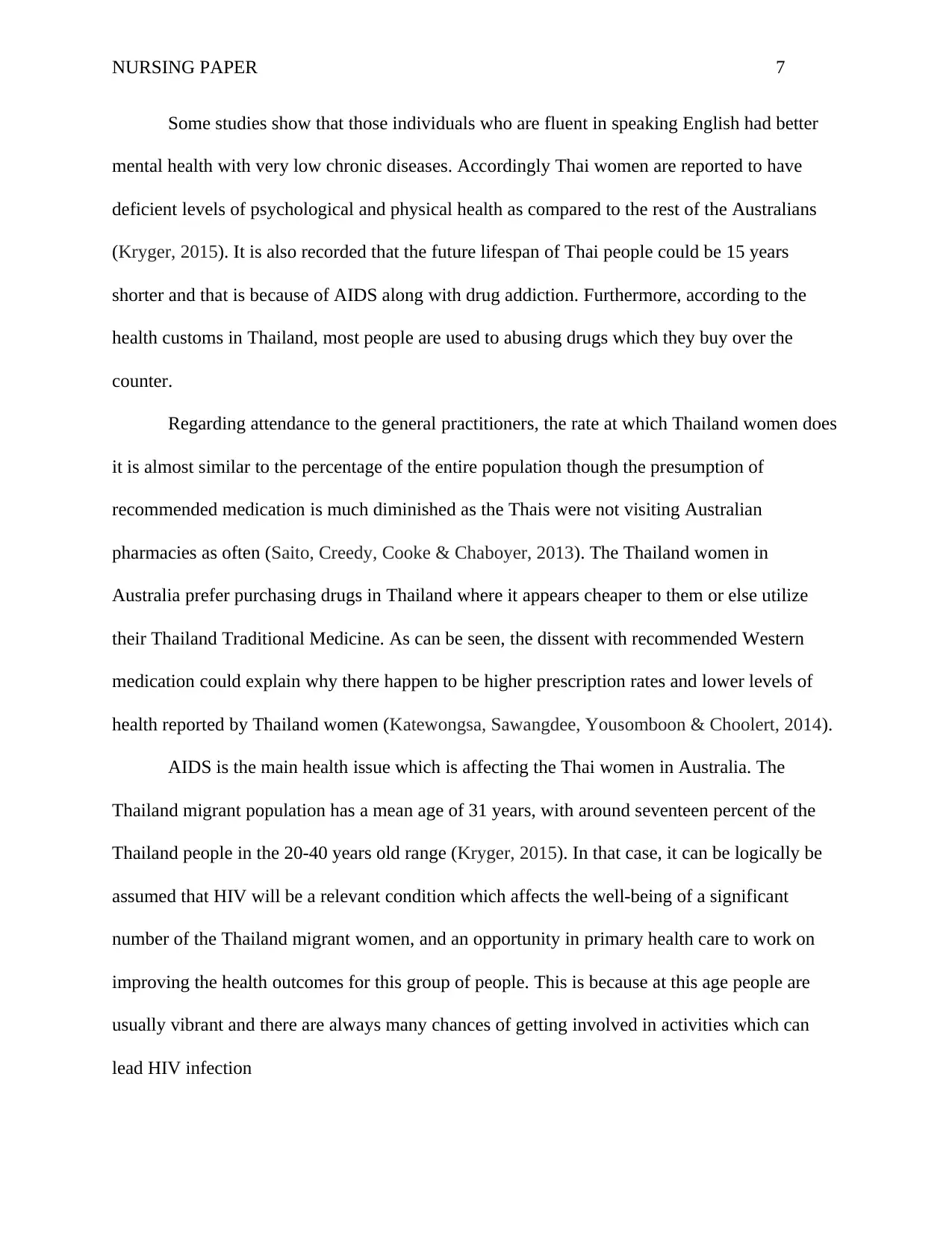
NURSING PAPER 7
Some studies show that those individuals who are fluent in speaking English had better
mental health with very low chronic diseases. Accordingly Thai women are reported to have
deficient levels of psychological and physical health as compared to the rest of the Australians
(Kryger, 2015). It is also recorded that the future lifespan of Thai people could be 15 years
shorter and that is because of AIDS along with drug addiction. Furthermore, according to the
health customs in Thailand, most people are used to abusing drugs which they buy over the
counter.
Regarding attendance to the general practitioners, the rate at which Thailand women does
it is almost similar to the percentage of the entire population though the presumption of
recommended medication is much diminished as the Thais were not visiting Australian
pharmacies as often (Saito, Creedy, Cooke & Chaboyer, 2013). The Thailand women in
Australia prefer purchasing drugs in Thailand where it appears cheaper to them or else utilize
their Thailand Traditional Medicine. As can be seen, the dissent with recommended Western
medication could explain why there happen to be higher prescription rates and lower levels of
health reported by Thailand women (Katewongsa, Sawangdee, Yousomboon & Choolert, 2014).
AIDS is the main health issue which is affecting the Thai women in Australia. The
Thailand migrant population has a mean age of 31 years, with around seventeen percent of the
Thailand people in the 20-40 years old range (Kryger, 2015). In that case, it can be logically be
assumed that HIV will be a relevant condition which affects the well-being of a significant
number of the Thailand migrant women, and an opportunity in primary health care to work on
improving the health outcomes for this group of people. This is because at this age people are
usually vibrant and there are always many chances of getting involved in activities which can
lead HIV infection
Some studies show that those individuals who are fluent in speaking English had better
mental health with very low chronic diseases. Accordingly Thai women are reported to have
deficient levels of psychological and physical health as compared to the rest of the Australians
(Kryger, 2015). It is also recorded that the future lifespan of Thai people could be 15 years
shorter and that is because of AIDS along with drug addiction. Furthermore, according to the
health customs in Thailand, most people are used to abusing drugs which they buy over the
counter.
Regarding attendance to the general practitioners, the rate at which Thailand women does
it is almost similar to the percentage of the entire population though the presumption of
recommended medication is much diminished as the Thais were not visiting Australian
pharmacies as often (Saito, Creedy, Cooke & Chaboyer, 2013). The Thailand women in
Australia prefer purchasing drugs in Thailand where it appears cheaper to them or else utilize
their Thailand Traditional Medicine. As can be seen, the dissent with recommended Western
medication could explain why there happen to be higher prescription rates and lower levels of
health reported by Thailand women (Katewongsa, Sawangdee, Yousomboon & Choolert, 2014).
AIDS is the main health issue which is affecting the Thai women in Australia. The
Thailand migrant population has a mean age of 31 years, with around seventeen percent of the
Thailand people in the 20-40 years old range (Kryger, 2015). In that case, it can be logically be
assumed that HIV will be a relevant condition which affects the well-being of a significant
number of the Thailand migrant women, and an opportunity in primary health care to work on
improving the health outcomes for this group of people. This is because at this age people are
usually vibrant and there are always many chances of getting involved in activities which can
lead HIV infection
Paraphrase This Document
Need a fresh take? Get an instant paraphrase of this document with our AI Paraphraser
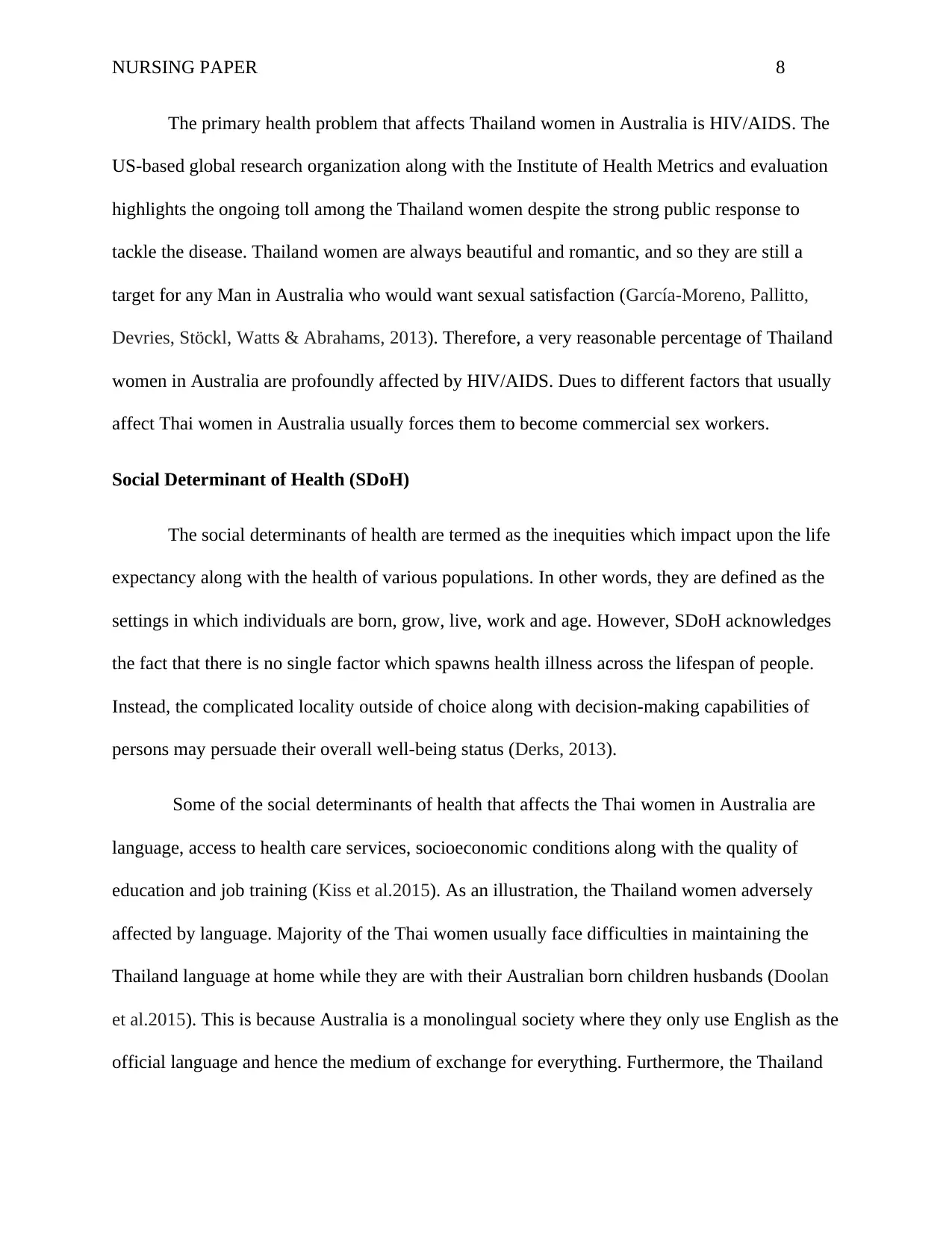
NURSING PAPER 8
The primary health problem that affects Thailand women in Australia is HIV/AIDS. The
US-based global research organization along with the Institute of Health Metrics and evaluation
highlights the ongoing toll among the Thailand women despite the strong public response to
tackle the disease. Thailand women are always beautiful and romantic, and so they are still a
target for any Man in Australia who would want sexual satisfaction (García-Moreno, Pallitto,
Devries, Stöckl, Watts & Abrahams, 2013). Therefore, a very reasonable percentage of Thailand
women in Australia are profoundly affected by HIV/AIDS. Dues to different factors that usually
affect Thai women in Australia usually forces them to become commercial sex workers.
Social Determinant of Health (SDoH)
The social determinants of health are termed as the inequities which impact upon the life
expectancy along with the health of various populations. In other words, they are defined as the
settings in which individuals are born, grow, live, work and age. However, SDoH acknowledges
the fact that there is no single factor which spawns health illness across the lifespan of people.
Instead, the complicated locality outside of choice along with decision-making capabilities of
persons may persuade their overall well-being status (Derks, 2013).
Some of the social determinants of health that affects the Thai women in Australia are
language, access to health care services, socioeconomic conditions along with the quality of
education and job training (Kiss et al.2015). As an illustration, the Thailand women adversely
affected by language. Majority of the Thai women usually face difficulties in maintaining the
Thailand language at home while they are with their Australian born children husbands (Doolan
et al.2015). This is because Australia is a monolingual society where they only use English as the
official language and hence the medium of exchange for everything. Furthermore, the Thailand
The primary health problem that affects Thailand women in Australia is HIV/AIDS. The
US-based global research organization along with the Institute of Health Metrics and evaluation
highlights the ongoing toll among the Thailand women despite the strong public response to
tackle the disease. Thailand women are always beautiful and romantic, and so they are still a
target for any Man in Australia who would want sexual satisfaction (García-Moreno, Pallitto,
Devries, Stöckl, Watts & Abrahams, 2013). Therefore, a very reasonable percentage of Thailand
women in Australia are profoundly affected by HIV/AIDS. Dues to different factors that usually
affect Thai women in Australia usually forces them to become commercial sex workers.
Social Determinant of Health (SDoH)
The social determinants of health are termed as the inequities which impact upon the life
expectancy along with the health of various populations. In other words, they are defined as the
settings in which individuals are born, grow, live, work and age. However, SDoH acknowledges
the fact that there is no single factor which spawns health illness across the lifespan of people.
Instead, the complicated locality outside of choice along with decision-making capabilities of
persons may persuade their overall well-being status (Derks, 2013).
Some of the social determinants of health that affects the Thai women in Australia are
language, access to health care services, socioeconomic conditions along with the quality of
education and job training (Kiss et al.2015). As an illustration, the Thailand women adversely
affected by language. Majority of the Thai women usually face difficulties in maintaining the
Thailand language at home while they are with their Australian born children husbands (Doolan
et al.2015). This is because Australia is a monolingual society where they only use English as the
official language and hence the medium of exchange for everything. Furthermore, the Thailand

NURSING PAPER 9
women usually struggle to find a comfort zone between their cultural traditions along with the
culture of their new homelands (Chew et al. 2016).
The Thailand culture along with the other small culture such as the Ishaan happens to be
the small cultures in Australia. However, it can result in disempowerment by mainstream
Australia to impact the well-being of people and hence increase the risk of premature deaths.
Accordingly, the issue of being different from the dominating cultural group avails the access
problems for Thailand migrant women in Australia. The Thai female migrants usually report that
while they can describe their medical problems, they find the process for gathering information
uncomfortably direct. In simple terms, they find Australian healthcare professionals to be
unfriendly and not sufficient to provide a test (Chew et al. 2016).
The cultural differences which usually results to racism, unemployment and
discrimination can feed exclusion from the mainstream society. In that case, the Thailand
migrant women do experience these risk factors at different levels. The access to mental health
services is usually a problem for Thailand women due to the fact they have issues with language
skills and hence they might not understand the descriptions in English correctly (Chatterji,
Baldwin, Prakash, Vlack & Lambert, 2014).
The Food culture is another issue. This happens to be a big part for all Thailand migrants
living in Australia. They mainly rely on the diet of glutinous rice. However, the unreliable
reports from a European trained RN who lived many years in Thailand is that incidence of seven
of diabetes in Thailand is high and it is due to excessive intake of glutinous rice (Srivastava,
Avan, Rajbangshi & Bhattacharyya, 2015). A check of the glycaemic index of glutinous rice
indicates that it has a GI rating of 98. In that case, if at all the Thailand women maintain their
traditional diet, it is likely that their glycaemic control will be affected.
women usually struggle to find a comfort zone between their cultural traditions along with the
culture of their new homelands (Chew et al. 2016).
The Thailand culture along with the other small culture such as the Ishaan happens to be
the small cultures in Australia. However, it can result in disempowerment by mainstream
Australia to impact the well-being of people and hence increase the risk of premature deaths.
Accordingly, the issue of being different from the dominating cultural group avails the access
problems for Thailand migrant women in Australia. The Thai female migrants usually report that
while they can describe their medical problems, they find the process for gathering information
uncomfortably direct. In simple terms, they find Australian healthcare professionals to be
unfriendly and not sufficient to provide a test (Chew et al. 2016).
The cultural differences which usually results to racism, unemployment and
discrimination can feed exclusion from the mainstream society. In that case, the Thailand
migrant women do experience these risk factors at different levels. The access to mental health
services is usually a problem for Thailand women due to the fact they have issues with language
skills and hence they might not understand the descriptions in English correctly (Chatterji,
Baldwin, Prakash, Vlack & Lambert, 2014).
The Food culture is another issue. This happens to be a big part for all Thailand migrants
living in Australia. They mainly rely on the diet of glutinous rice. However, the unreliable
reports from a European trained RN who lived many years in Thailand is that incidence of seven
of diabetes in Thailand is high and it is due to excessive intake of glutinous rice (Srivastava,
Avan, Rajbangshi & Bhattacharyya, 2015). A check of the glycaemic index of glutinous rice
indicates that it has a GI rating of 98. In that case, if at all the Thailand women maintain their
traditional diet, it is likely that their glycaemic control will be affected.
⊘ This is a preview!⊘
Do you want full access?
Subscribe today to unlock all pages.

Trusted by 1+ million students worldwide
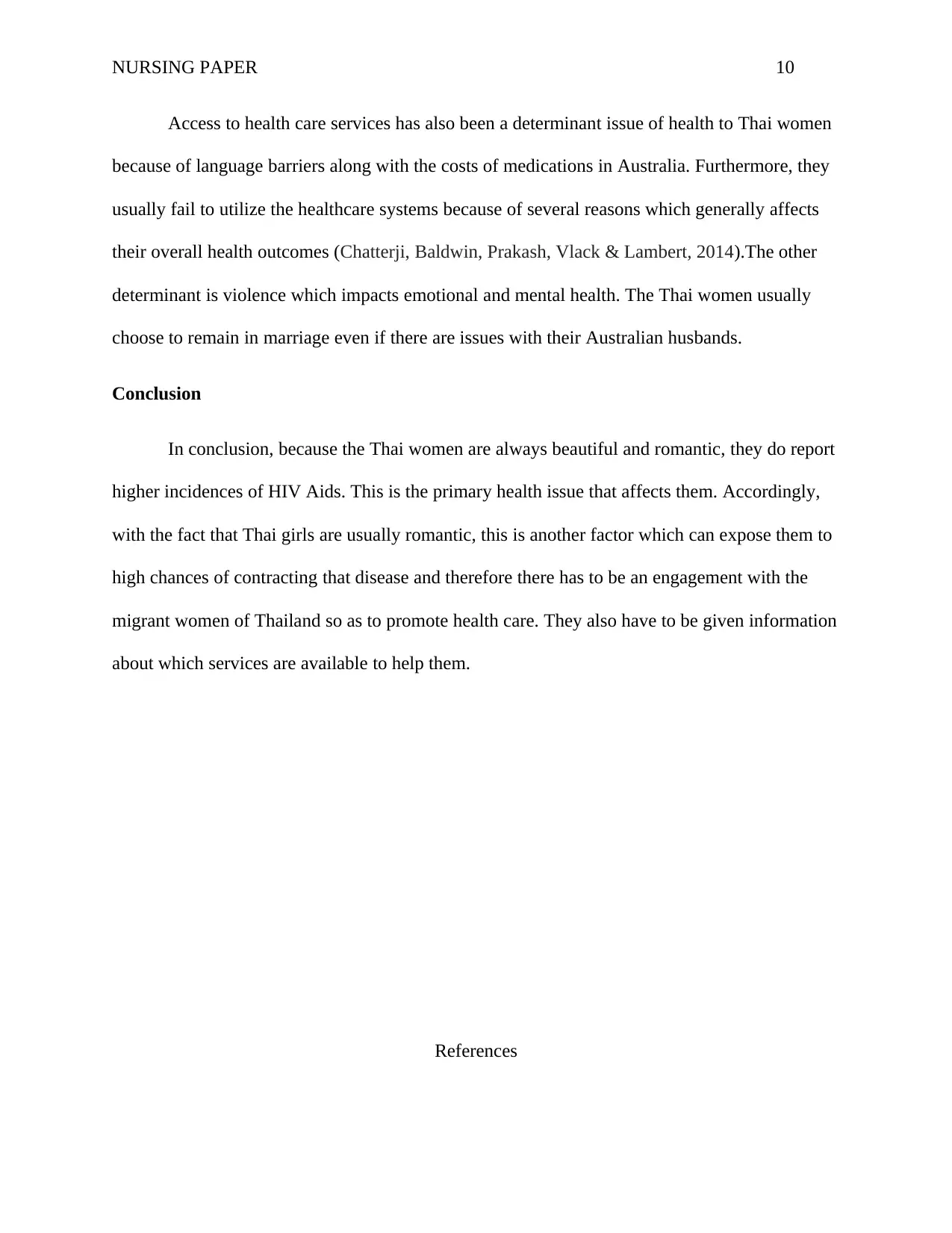
NURSING PAPER 10
Access to health care services has also been a determinant issue of health to Thai women
because of language barriers along with the costs of medications in Australia. Furthermore, they
usually fail to utilize the healthcare systems because of several reasons which generally affects
their overall health outcomes (Chatterji, Baldwin, Prakash, Vlack & Lambert, 2014).The other
determinant is violence which impacts emotional and mental health. The Thai women usually
choose to remain in marriage even if there are issues with their Australian husbands.
Conclusion
In conclusion, because the Thai women are always beautiful and romantic, they do report
higher incidences of HIV Aids. This is the primary health issue that affects them. Accordingly,
with the fact that Thai girls are usually romantic, this is another factor which can expose them to
high chances of contracting that disease and therefore there has to be an engagement with the
migrant women of Thailand so as to promote health care. They also have to be given information
about which services are available to help them.
References
Access to health care services has also been a determinant issue of health to Thai women
because of language barriers along with the costs of medications in Australia. Furthermore, they
usually fail to utilize the healthcare systems because of several reasons which generally affects
their overall health outcomes (Chatterji, Baldwin, Prakash, Vlack & Lambert, 2014).The other
determinant is violence which impacts emotional and mental health. The Thai women usually
choose to remain in marriage even if there are issues with their Australian husbands.
Conclusion
In conclusion, because the Thai women are always beautiful and romantic, they do report
higher incidences of HIV Aids. This is the primary health issue that affects them. Accordingly,
with the fact that Thai girls are usually romantic, this is another factor which can expose them to
high chances of contracting that disease and therefore there has to be an engagement with the
migrant women of Thailand so as to promote health care. They also have to be given information
about which services are available to help them.
References
Paraphrase This Document
Need a fresh take? Get an instant paraphrase of this document with our AI Paraphraser

NURSING PAPER 11
Byles, J., Perry, L., Parkinson, L., Bellchambers, H., Moxey, A., & Howie, A. (2015).
Encouraging best practice nutrition and hydration in residential aged care. Final report:
Australian Government Department of Health & Ageing 2009.
Chatterji, M., Baldwin, A. M., Prakash, R., Vlack, S. A., & Lambert, S. B. (2014). Public health
response to a measles outbreak in a large correctional facility, Queensland,
2013. Communicable diseases intelligence quarterly report, 38(4), e294-e297.
Chew, D. P., Scott, I. A., Cullen, L., French, J. K., Briffa, T. G., Tideman, P. A., ... & Aylward,
P. E. (2016). National Heart Foundation of Australia & Cardiac Society of Australia and
New Zealand: Australian clinical guidelines for the management of acute coronary
syndromes 2016. Heart, Lung and Circulation, 25(9), 895-951.
Cox, P. (2015). Violence against women in Australia: additional analysis of the Australian
Bureau of Statistics' Personal Safety Survey, 2012. ANROWS.
Derks, A. (2013). Human rights and (im) mobility: Migrants and the State in
Thailand. SOJOURN: Journal of Social Issues in Southeast Asia, 28(2), 216-240.
Doolan, I., Najman, J., Henderson, S., Cherney, A., Plotnikova, M., Ward, J., ... & Smirnov, A.
(2015). A retrospective comparison study of Aboriginal and Torres Strait Islander
injecting drug users and their contact with youth detention and/or prison. Australian
Indigenous Health Bulletin, 15(4).
García-Moreno, C., Pallitto, C., Devries, K., Stöckl, H., Watts, C., & Abrahams, N.
(2013). Global and regional estimates of violence against women: prevalence and health
effects of intimate partner violence and non-partner sexual violence. World Health
Organization
Byles, J., Perry, L., Parkinson, L., Bellchambers, H., Moxey, A., & Howie, A. (2015).
Encouraging best practice nutrition and hydration in residential aged care. Final report:
Australian Government Department of Health & Ageing 2009.
Chatterji, M., Baldwin, A. M., Prakash, R., Vlack, S. A., & Lambert, S. B. (2014). Public health
response to a measles outbreak in a large correctional facility, Queensland,
2013. Communicable diseases intelligence quarterly report, 38(4), e294-e297.
Chew, D. P., Scott, I. A., Cullen, L., French, J. K., Briffa, T. G., Tideman, P. A., ... & Aylward,
P. E. (2016). National Heart Foundation of Australia & Cardiac Society of Australia and
New Zealand: Australian clinical guidelines for the management of acute coronary
syndromes 2016. Heart, Lung and Circulation, 25(9), 895-951.
Cox, P. (2015). Violence against women in Australia: additional analysis of the Australian
Bureau of Statistics' Personal Safety Survey, 2012. ANROWS.
Derks, A. (2013). Human rights and (im) mobility: Migrants and the State in
Thailand. SOJOURN: Journal of Social Issues in Southeast Asia, 28(2), 216-240.
Doolan, I., Najman, J., Henderson, S., Cherney, A., Plotnikova, M., Ward, J., ... & Smirnov, A.
(2015). A retrospective comparison study of Aboriginal and Torres Strait Islander
injecting drug users and their contact with youth detention and/or prison. Australian
Indigenous Health Bulletin, 15(4).
García-Moreno, C., Pallitto, C., Devries, K., Stöckl, H., Watts, C., & Abrahams, N.
(2013). Global and regional estimates of violence against women: prevalence and health
effects of intimate partner violence and non-partner sexual violence. World Health
Organization
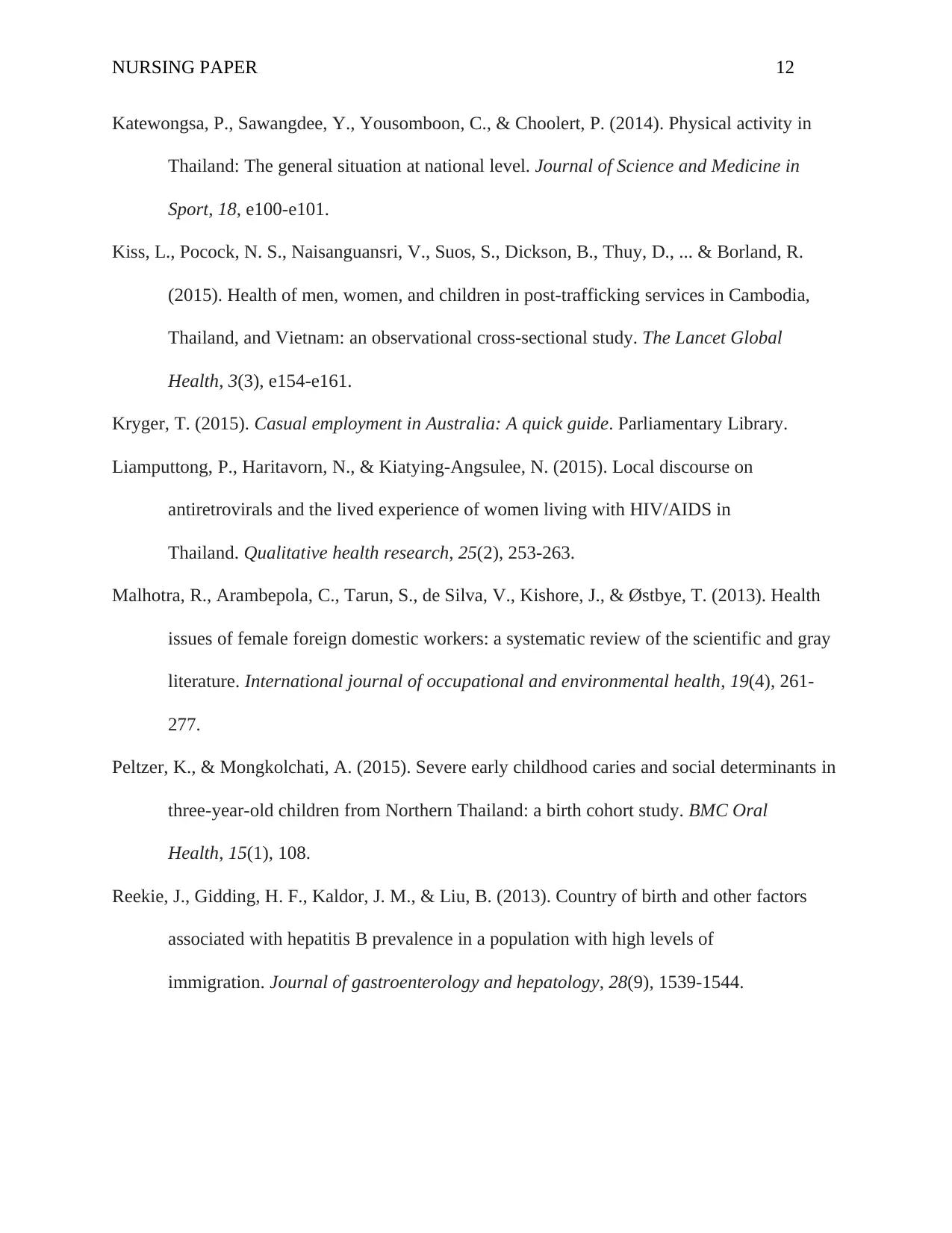
NURSING PAPER 12
Katewongsa, P., Sawangdee, Y., Yousomboon, C., & Choolert, P. (2014). Physical activity in
Thailand: The general situation at national level. Journal of Science and Medicine in
Sport, 18, e100-e101.
Kiss, L., Pocock, N. S., Naisanguansri, V., Suos, S., Dickson, B., Thuy, D., ... & Borland, R.
(2015). Health of men, women, and children in post-trafficking services in Cambodia,
Thailand, and Vietnam: an observational cross-sectional study. The Lancet Global
Health, 3(3), e154-e161.
Kryger, T. (2015). Casual employment in Australia: A quick guide. Parliamentary Library.
Liamputtong, P., Haritavorn, N., & Kiatying-Angsulee, N. (2015). Local discourse on
antiretrovirals and the lived experience of women living with HIV/AIDS in
Thailand. Qualitative health research, 25(2), 253-263.
Malhotra, R., Arambepola, C., Tarun, S., de Silva, V., Kishore, J., & Østbye, T. (2013). Health
issues of female foreign domestic workers: a systematic review of the scientific and gray
literature. International journal of occupational and environmental health, 19(4), 261-
277.
Peltzer, K., & Mongkolchati, A. (2015). Severe early childhood caries and social determinants in
three-year-old children from Northern Thailand: a birth cohort study. BMC Oral
Health, 15(1), 108.
Reekie, J., Gidding, H. F., Kaldor, J. M., & Liu, B. (2013). Country of birth and other factors
associated with hepatitis B prevalence in a population with high levels of
immigration. Journal of gastroenterology and hepatology, 28(9), 1539-1544.
Katewongsa, P., Sawangdee, Y., Yousomboon, C., & Choolert, P. (2014). Physical activity in
Thailand: The general situation at national level. Journal of Science and Medicine in
Sport, 18, e100-e101.
Kiss, L., Pocock, N. S., Naisanguansri, V., Suos, S., Dickson, B., Thuy, D., ... & Borland, R.
(2015). Health of men, women, and children in post-trafficking services in Cambodia,
Thailand, and Vietnam: an observational cross-sectional study. The Lancet Global
Health, 3(3), e154-e161.
Kryger, T. (2015). Casual employment in Australia: A quick guide. Parliamentary Library.
Liamputtong, P., Haritavorn, N., & Kiatying-Angsulee, N. (2015). Local discourse on
antiretrovirals and the lived experience of women living with HIV/AIDS in
Thailand. Qualitative health research, 25(2), 253-263.
Malhotra, R., Arambepola, C., Tarun, S., de Silva, V., Kishore, J., & Østbye, T. (2013). Health
issues of female foreign domestic workers: a systematic review of the scientific and gray
literature. International journal of occupational and environmental health, 19(4), 261-
277.
Peltzer, K., & Mongkolchati, A. (2015). Severe early childhood caries and social determinants in
three-year-old children from Northern Thailand: a birth cohort study. BMC Oral
Health, 15(1), 108.
Reekie, J., Gidding, H. F., Kaldor, J. M., & Liu, B. (2013). Country of birth and other factors
associated with hepatitis B prevalence in a population with high levels of
immigration. Journal of gastroenterology and hepatology, 28(9), 1539-1544.
⊘ This is a preview!⊘
Do you want full access?
Subscribe today to unlock all pages.

Trusted by 1+ million students worldwide
1 out of 13
Your All-in-One AI-Powered Toolkit for Academic Success.
+13062052269
info@desklib.com
Available 24*7 on WhatsApp / Email
![[object Object]](/_next/static/media/star-bottom.7253800d.svg)
Unlock your academic potential
Copyright © 2020–2025 A2Z Services. All Rights Reserved. Developed and managed by ZUCOL.
